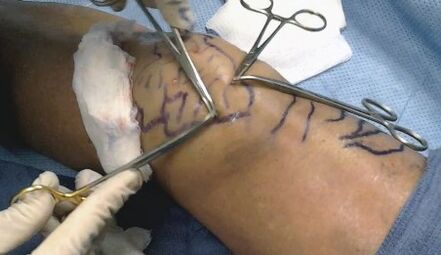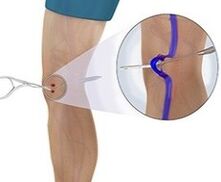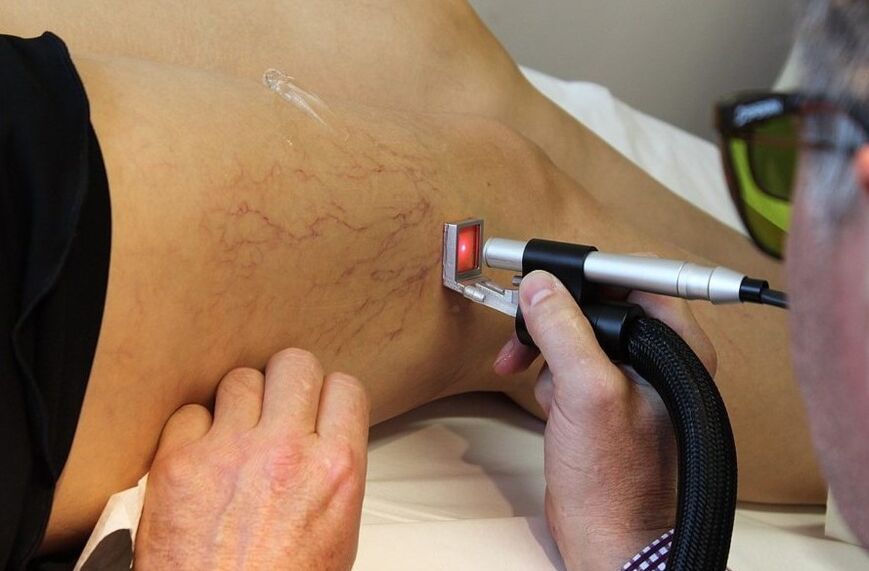Varicose veins on the legs are manifested by ugly thickenings, and if men experience only physical discomfort, then for women this means a significant cosmetic drawback.Conservative treatment methods only allow you to slow down the development of the disease.Once and for all, the defect is eliminated only surgically.Flebectomy is a traditional surgical method of treating varicose veins - the exclusion of pathologically altered veins from the circulatory system in order to normalize it.In the process of surgical intervention, areas of altered veins with minimal blood flow are excluded.
Phleubectomy is prescribed if the patient suffers:

- Vast varicose veins;
- Severe fatigue and swelling of the legs in the area of the lower leg, burdened by varicose veins;
- Complications of varicose veins;
- Impaired outflow of blood;
- Trophic ulcers and thrombophlebitis;
For the body, such changes are calm.The absence of problems is due to the fact that the deep veins have a slight increase in the load.
The operation in the vast majority of cases gives a good result - the outflow of blood comes back to normal, the cosmetic defect is eliminated.People with extended legs are recommended to carry out such treatment.
Less traumatic method is laser phlebectomy:
- The procedure is carried out without general anesthesia;
- There is no need to make cuts in the groin and in the popliteal area, apply seams;
- Long hospitalization is not required.
Indications for the operation
PHLEBECTOMY is assigned when the problem has accepted serious turnover, and conservative methods cannot correct the situation.The operation is a radical way to eliminate venous insufficiency, when there is a risk of the formation of trophic ulcers and the development of thrombosis.
During the operation, the most modern methods are used to minimize damage.Additional normalizing factors are:
- Use of special drugs;
- Wearing compression linen.
PHLEBECTOMY is carried out when:
- The protruding swollen veins are clearly expressed;
- The patient has acute thrombophlebitis;
- On both legs there are trophic ulcers;
- The affected veins bleed;
- The patient has extensive varicose veins;
- The swelling of the legs almost never leaves;
- A constant feeling of fatigue.
The degree of disease and the optimal treatment method is determined by the doctor.
Restrictions for the operation are rarely used:
- The risk of varicose progression is too great;
- Modern methods are little traumatic;
- Rehabilitation takes place without complications.
Contraindications to the operation are:
- Hypertension, coronary disease;
- Varicose veins in an advanced stage;
- Severe infectious processes in the body;
- Severe diseases of an inflammatory nature (eczema);
- Advanced age;
- Pregnancy in the late stages;
- Stroke, heart attack, diabetes.
How the operation takes place
PHLEBOLOGIST directs the patient to diagnostic procedures, the results of which determine the possibility of surgical treatment.Ultrasound studies of blood vessels and veins can be prescribed (if necessary).
The most commonly carried out combined Phlebectomy - they use various methods depending on the stage of development of the disease and on what vessels affect.
What does combined phlebectomy include
The classic operational method of treating varicose veins currently combines several surgical techniques. The main task is to eliminate the pathological reverse current (Reflux).This can only be done by stopping blood flow, which is achieved:
- Dressing;
- Removal of pathologically altered areas;
- The destructive effect on the inner surface of the vessels is chemical or physical.
The main stages of the combined operation are most often the same, and differ only in the features of surgical technology.

CrossCtomy
The method is used in the complicated course of the disease and provides for the intersection of a changed vein in the area where the subcutaneous vein flows into Femoral.The ligation of a large subcutaneous vein and its small branches is carried out.After surgery, cosmetic seams are applied.The method is independent.Such an intervention is carried out according to emergency indications with a threat of thrombophlebitis.This is the only type of quick little traumatic intervention with urgent need to stop the return flow of blood.The volume of surgery is limited due to severe inflammation.With a complex approach, surface veins are bandaged.
Saphenectomy
The low-invasive methodology for the treatment of varicose veins, which is prescribed in severe course of the disease-with the help of additional incisions and punctures, the affected vein is completely removed.The excision of large veins is also used.If necessary, you can remove the vessel in parts.At the end of the procedure, punctures are closed with special ribbons.
The purpose of surgery is to eliminate the mechanism that helps to expand the blood vessels.During the operation, the central trunks of the affected veins are removed.The operation is carried out quickly and painlessly.
Negative moments:
- Prolonged healing of scars;
- Long rehabilitation period;
- Scars remain on the skin.
The procedure is quite effective so that after it the patient can play sports.
Stripping
This is the operation of raising veins using a thin probe.During surgical intervention, a vein is opened and a metal probe is introduced, which allows it to separate it from other fabrics.The method allows you to remove only a given area of the damaged vein.

The advantage of this technology is slightly invasive.Manipulation is carried out through a small puncture (4-5 mm).For minimal tissue injury, special equipment is used.The seam remains unnoticed.The recovery period is extremely short.
Traditional phlebectomy or laser
One of the latest methods for the treatment of varicose veins is the use of a laser beam controlled by a computer.Modern equipment with a special micro-lines allows you to scatter and evenly distribute laser radiation, so the effect of high-quality soldering of veins of any size is achieved.The technique allows you to influence high accuracy, providing 100% reliability.The puncture in the fabrics is small, a thin probe is pre -introduced into the vein.Manipulation is carried out under local anesthesia, the patient does not feel unpleasant effects.After the procedure, hematomas are less pronounced.
How is the preparation
To perform endoscopic phlebectomy, there is no need to prepare in advance.To prepare the patient for the operation is enough:
- Take a shower;
- Sharp the hair in the problem area very thoroughly.
Epidural anesthesia is used to completely exclude unpleasant sensations and pain.The duration of the operation depends on the complexity and the selected method of exposure.The average indicator is 3 hours.

In the absence of complications, the patient spends no more than two days in the daily hospital.After this period, he will be restored at home.In fact, rehabilitation takes a little longer, and for the successful passage of this stage it is important to follow certain rules.It is necessary to wear special compression linen for 3 days.
They will increase the chances of quick and complete recovery:
- Light massage;
- Performing a complex of exercises of exercise therapy;
- Gymnastics.
Physical activity should be excluded, not to visit pools and saunas so as not to provoke complications.In the first days after surgery, hematomas, small seals, swelling may remain on the skin.These phenomena fit into normal, and there is no need to worry about this.A few days later they will disappear without a trace.Remove the seams on 8-9 days.Over the next month, compression linen must be worn.2 weeks after the operation, an inspection is carried out.The next visits to the doctor and ultrasound are carried out after 2 months.
Possible complications
Immediately or after some time after surgery, complications may occur.Even a small probability of such a development of events should be taken into account.
The main complications can be as follows:
- After manipulation, there is no sensitivity;
- The inside of the lower leg and ankle are numb;
- Bleeding;
- Swelling of the foot;
- Suppuration in the place of hematoma;
- In close proximity to the sore area, signs of varicose veins (relapse) are manifested;
- Change in the color of the skin, numerous bruises;
- Swelling and soreness.
To minimize the risk of complications, patients must exactly follow the doctor's recommendations.
After the operation, the doctor will tell the patient:
- How much you can walk at first;
- What exercises to perform;
- What physical activity is considered balanced;
- What diet to adhere to.
How much does the operation of eliminating varicose veins of the lower extremities cost
For patients familiar with varicose veins, the issue of inexpensive and effective operation remains relevant.It is important that the manipulations are carried out without consequences, and the varicose veins disappeared.In the Clinic of the Russian Academy of Sciences, doctors guarantee complete getting rid of the problem.For patients of advanced age and young people, the chances of success are equally high.Each patient can receive a detailed consultation and recommendations for:
- The need to conduct an operation;
- Duration of manipulation;
- How long will be pain;
- What time will need to be spent in the hospital;
- Is it possible to get rid of scars.
Knowing the answers to all questions of interest, it is much easier to agree to surgical treatment.The clinic specialists will select the best option for the methodology of the procedure that is most suitable in each case.The cost of the service is largely determined by the chosen technique of its implementation.
























